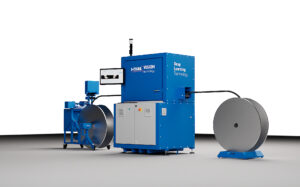The automotive industry is undergoing one of its biggest transformations since the advent of robotization. Today, machine vision has become a strategic pillar for improving quality, increasing safety, and optimizing processes that previously depended exclusively on human supervision.
At I-MAS, we see it every day in the projects we develop: the combination of advanced optics, AI algorithms, and automation is no longer a trend, it is a technological standard that makes a difference.
In this article, we present five areas where computer vision is forever changing the way vehicles are designed, produced, and validated.
Ultra-precise quality control on the production line
Accuracy and repeatability are essential in any assembly line, but especially in the automotive industry. Machine vision systems can inspect components in milliseconds, detecting defects that are impossible to identify with the naked eye: microcracks, dimensional variations, assembly errors, or imperfections in painted surfaces.
These solutions provide:
- Consistent 24/7 inspections without human variability.
- Complete traceability of each unit manufactured.
- Drastic reduction in scrap and rework.
At I-MAS, we integrate industrial cameras, specialized optics, and proprietary algorithms that enable reliable part validation even in complex environments: vibrations, lighting changes, or high line speeds.
Smarter robotization thanks to 3D vision
The rise of collaborative robotics and autonomous mobile robots (AMRs) requires systems capable of “seeing” their surroundings. 3D computer vision enables robots to identify objects, calculate distances, and make decisions in real time.
Some of its key applications are:
- Pick & place with disordered parts in containers.
- Intelligent palletizing and depalletizing.
- Precise guidance in assembly tasks.
With these technologies, robotics is no longer rigid and can adapt to changing scenarios, allowing operations that were previously too variable for a traditional robot to be automated.
Safety and ADAS validation in vehicles
ADAS (Advanced Driver Assistance Systems) are now standard. Automatic braking, lane control, and parking assistance are developed and validated using advanced computer vision solutions that analyze road behavior and real driving conditions.
Manufacturers use platforms with multi-layer cameras, stereoscopic sensors, and algorithms capable of recognizing pedestrians, signs, lines, or vehicles at high speeds. The quality of these systems has a direct impact on user safety, which is why their validation requires precision, repeatability, and the ability to simulate hundreds of different scenarios.
Non-contact digital measurement and metrology
Artificial vision has replaced traditional tools in metrology tasks. Today, it is possible to measure tolerances with high-resolution cameras and laser projectors without the need for contact. Some of the main advantages are: faster part verification, reduction of errors resulting from manual handling, and complete digitization of the metrology process.
At I-MAS, we develop customized solutions that combine 2D and 3D vision to obtain accurate data on machined parts, structural components, or bodywork elements.
Traceability and automation of the logistics process
Artificial vision also extends beyond the production process. In warehouses and automated logistics areas, it allows for the control of incoming and outgoing goods, the identification of references, the verification of packaging, and the monitoring of material condition.
This technology integrates OCR, code reading, shape recognition, and pattern analysis to prevent supply errors, detect discrepancies between orders and actual material, and optimize inventory management.
This makes internal logistics a more reliable process that is aligned with production requirements.
I-MAS: Towards more precise, efficient, and connected automotive technology
Computer vision is not just an inspection tool: it is a strategic element for digitizing the automotive industry. It provides control, speed, and consistency, enabling manufacturers to meet the current challenges facing the sector: electrification, customization, more demanding delivery times, and international quality standards.
At I-MAS, we help companies integrate these technologies into their processes, from conceptualization to the implementation of turnkey solutions, combining mechanical engineering, electronics, software, AI, and automation.
The new generation of automotive plants will be smarter, more autonomous, and more flexible. And computer vision is one of the pillars that will make this possible.
Want to learn more about our services? Contact us or visit our projects section!



